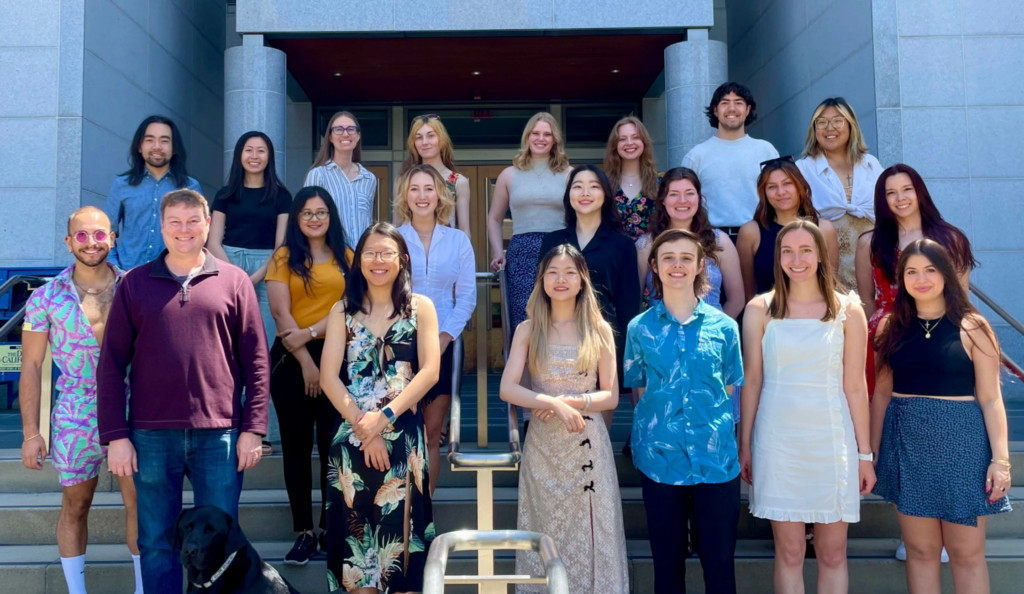Matthew Francis is a professor in the Department of Chemistry. Research in the Francis lab is focused on the development of new synthetic methods for site-specific protein modification. These new reactions are then applied to the construction of protein-based materials with useful optical and therapeutic functions. Current areas of research include (1) the development of nanoscale carriers for drug molecules and imaging agents using chemically modified viral capsids; (2) the study of natural and artificial light harvesting systems; (3) the synthesis of new protein-based materials for environmental applications; and (4) the attachment of living cells to device surfaces through DNA-based adhesion.
QB3-Berkeley: Are there any current lab projects that you’d be willing to share with us?
Matthew Francis: We’re very excited about a lot of projects going on in the lab right now. One in particular is a new chemical reaction we have developed to couple full-sized proteins together. Using the enzyme tyrosinase, we can link two or more proteins through cysteine and tyrosine residues. The tyrosine needs to be at the N- or C-terminus of the protein, but the cysteine can be anywhere on the protein surface. By moving the cysteine residue group around using standard techniques, we can change the positions through which the proteins are joined together. Using this chemistry, we are currently making bi-specific engagers for cancer cells and T cells, with control over the geometry with which the cells come together. This is perhaps for the first time this has been possible, and we hypothesize that this will have important effects on how effective these anti-cancer agents are. One thing that’s great about being in QB3 and in Stanley Hall is that there are people all around us working with interesting proteins with interesting properties. We’d love to collaborate with other groups in the building to join their proteins of interest together and ask new questions about the systems that they are working on.
QB3: What inspires your work?
MF: Ever since I was a little kid, I’ve always loved to make and build things. That’s true for a lot with organic chemists. But the more I continue our lab’s work—and the more tools we learn in both organic chemistry and biochemistry—the more excited I get to make new types of protein constructs that could not be made before. I get a lot of inspiration from that. Putting organic chemistry in the context of protein modification is one of the big driving forces for me as a scientist.
QB3: What do you enjoy about working with trainees in your lab?
MF: It continually amazes me to see how creative and innovative UC Berkeley’s students are. Working with undergraduates, grad students, and postdocs is such a creative period in their careers in terms of research—they’re here to take that step from classroom learning to coming up with their own ideas or implementing those ideas into new experimental designs. That is an exciting time to be part of someone’s development. I have always looked at this group as a big collaboration between me and all of the trainees, rather than using a top-down approach. We develop our ideas together, and we are so much stronger scientifically because of every single person in our lab. Not only does that make our science a lot more effective; it also makes science a lot more fun.
QB3: What defines your lab’s culture?
MF: I would describe our lab culture as fairly laid back. Yes, we work hard, but the group is very good about not making me the ‘dad’ or the ‘boss.’ It’s a much more collaborative atmosphere and one where, if anything, I’m more like the dysfunctional, older sibling who’s just been around a little while! We also do a lot of activities together outside the lab. Every year—except 2021—we’ve gone on a ski trip together. We also usually do summer trips as well: We’ve hiked Half Dome a couple times, we’ve gone up the Mendocino coast, and we have been whitewater rafting. That goes along with our work hard, play hard culture. And we do we have a great time together.
QB3: What does being part of QB3-Berkeley mean to you?
MF: When I was looking for jobs a little over 20 years ago, QB3 and the Molecular Foundry were two were two brand-new initiatives at UC Berkeley and the Lawrence Berkeley National Laboratory, respectively. Both of these organizations represent collaborative environments that are dedicated to addressing scientific challenges that are bigger than a single lab can tackle, such as climate change, new energy efficient batteries for cars, new methods for cancer immunotherapy, and new antibiotic discovery. I really believe this collaborative approach is essential to the future of science, and therefore both QB3 and LBNL had a lot to do with me deciding to take a job here at Berkeley. As much as I cherish being part of the Department of Chemistry, there are so many new areas of research that we can expand into with our QB3 and LBNL colleagues. We’re inspired by many labs around us, and the interesting proteins that they’re working with. Working with other QB3-Berkeley labs also helps us develop new ideas about systems that we can build and new therapies that we can implement.